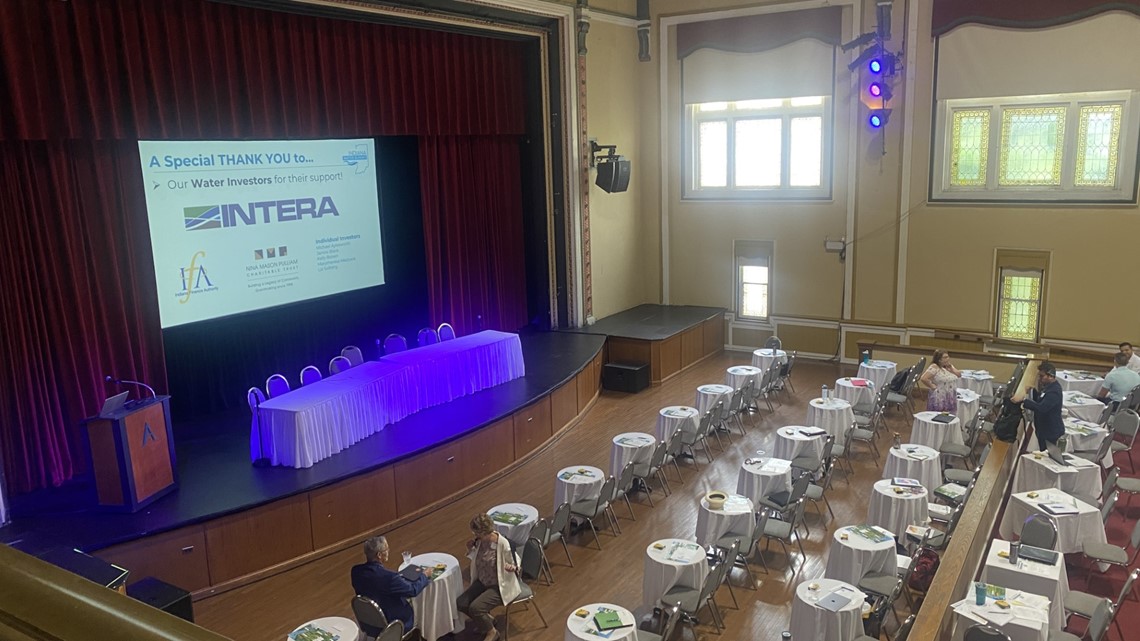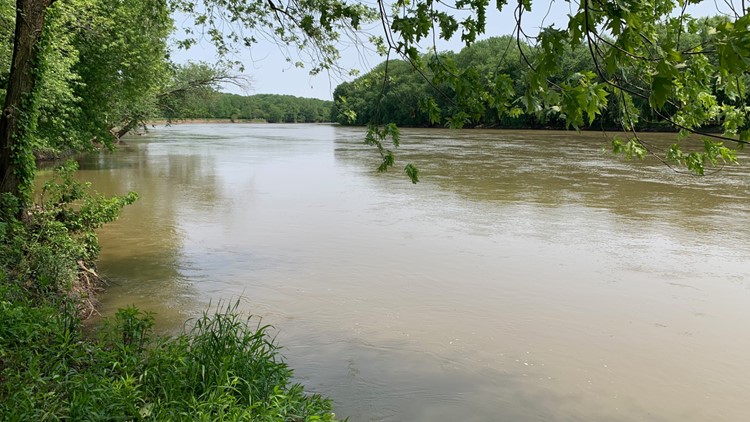INDIANAPOLIS — Tasked with delivering solutions on how to increase water access and improve quality for millions of people throughout Indiana as the planet warms, researchers, advocates and policymakers convened at the Athenaeum in downtown Indianapolis for the final day of the Indiana Water Summit on Friday.
Central themes discussed on day two of the summit included how officials are dealing with water issues related to climate change in the state and how Hoosiers can make water systems more resilient while leveraging existing federal funds to do so.
The first panel addressed climate specifically and consisted of leaders from the Indiana Water Resources Research Center, the IU Environmental Resiliency Institute, IN-Climate and Representative Cary Hamilton.
Dr. Gabe Filippelli leads the Environmental Resiliency Institute based out of Indiana University, which was established in 2017 to address environmental justice and resiliency issues in Indiana. Against the backdrop of the most deadly fire in Hawaii's history and a summer saw heat records shattered worldwide, Filippelli touched on the immediate need to address fossil fuels emissions.
"[Climate change] is happening to us because you're putting warming gases in the atmosphere by burning fossil fuels - it'll stop when we stop putting warming gases to the atmosphere from burning fossil fuels," said Filippelli, whose novel Climate Change and Resilience in Indiana and Beyond addressing climate risks and solutions in Indiana was published last year.
Projections over how waterways were changing throughout the state because of emmisons fueled climate change were detailed in the Indiana Climate Change Impacts Assessment. It was published in June, and shared with the summit by Dr. Keith Cherkauer, who is the Professor of Agricultural and Biological Engineering Director with the Indiana Water Resources Research Center.
"A lot of what we're looking at is - we're getting a little bit wetter, but we're also getting a little bit dryer. Our extremes are getting a little stretched out," Cherkauer said.
Researchers predicted precipitation increases would happen in the winter and spring, making for wetter spring conditions that could saturate soil.
Summer precipitations are projected to remain the same, or decrease slightly, by 2 percent according to the report, but the intensity of summer storm events is projected to increase.
Ongoing increases in temperature are expected to accelerate and raise evapotranspiration rates, or the amount of moisture lost to plant use and evaporation from surface soils and water, by 5 to 6 percent across Indiana by midcentury, the report said.
Inconsistent stream flows are also projected to exacerbate water quality issues throughout Indiana, as an influx of rain can lead to sediment and nutrient infiltrating our drinking water, while drought periods concentrate pollutants throughout waterways.
An inconsistent climate will, leaders stressed, continue taxing an already aging water infrastructure throughout Indiana.
The resiliency of underground systems designed to supply clean water into homes, transport sewage and stormwater away from homes, and send water safely downstream to the next town will need to withstand deluges of excess water from more severe precipitation events, while holding up during those micro-drought periods.
In Indianapolis, this stressed system will need to support the water needs to a growing population of 1.4 million people.
Speakers highlighted the need to revamp Indiana's aging water infrastructures, and urged public officials to invest in green solutions to do so.
Representative Casey Hamilton represents Indiana District 87 offered insight into the difficulty she's had putting forward resolutions at the statehouse that would create a Climate Change Task Force. She first tried to put forward a bill to create a task force during the 2020 legislative session, but was unsuccessful. "We desperately need a coordinated, state led conversation to build consensus on some things we need to leverage federal dollars today," Hamilton said.
Taking advantage of an influx of federal funds, offered by the Inflation Reduction Act and infrastructure bill enacted over the past few years, was a touching point for panelists, who urged businesses and organizers to take advantage of them before they go away.


"What we need to do is make sure that all of this firehose of federal funding to deal with climate change doesn't divert Indiana and go to Ohio, Illinois, and Michigan, right. So, we need to inundate our communities and businesses with information, so they can tap into this," Filipelli said.
The Inflation Reduction Act created more than 170,000 jobs across 44 states since the Inflation Reduction Act took effect in Aug. 16, 2022, according to a report from the Clean Energy Boom. But leaders at the summit said Indiana is falling behind neighboring states in utilizing those funds.
"Kentucky has gotten 10 times more federal funding from these two bills so far. So, let's catch up with Kentucky. Regional planning seems to be an advantage when grant windows are short and you need to be able to jump on it. Take advantage of this historical level of federal funding that we've never seen before," Brown said.
Another solution to safeguard Indiana's water from climate change is through investing in green infrastructure, or nature-based solutions. Even the best laid solutions for dealing with climate change through so-called grey solutions - updates in infrastructure like dams, roads, pipes or water treatments plans - are failing, because they largely rely on outdated modeling for construction.
As air temperatures warm, more water vapor is held in the atmosphere and discharged during rainfall events. Research from the First Street Foundation released in June posits that for 1°C increase, 7% more water vapor is carried by the same air volume.
Warming temperatures can create changes in the intensity, duration and frequency of rainfall events. Now events that were thought to occur only once every hundred years are now, according to the report, occurring with far greater frequency.
Scientists Dr. Antonio Arenas and Dr. Lu Liu from Iowa State University presented that study to the summit during a panel on the climate's impact on water infrastructure, and said officials and engineers are designing infrastructure based on a climate in which we no longer live.
"Nobody's making a mistake or error. It's that using old data is not enough to assess our current infrastructure," Arenas said.
Other speakers at the summit Friday discussed how outdated maps are affecting Indiana water infrastructure investments, outlined ongoing risks to water resources, reiterated best ways to access funding opportunities, and focused on water policy priorities for Indiana leaders.
Thursday's summit focused on watershed planning and management on a regional scale, strategic infrastructure investments, supporting Indiana's water needs and addressing data gaps.
It is the sixth annual water summit held in the state, and is hosted by The White River Alliance.



